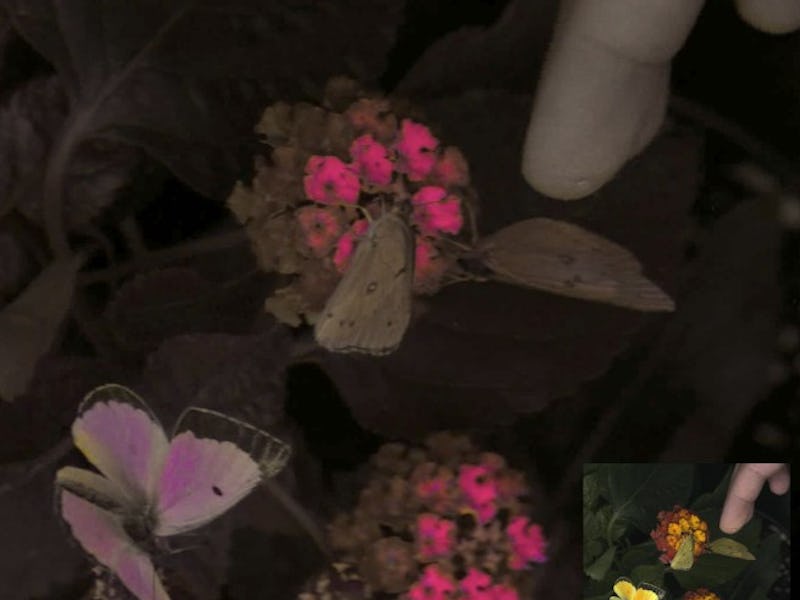Look! Cutting-Edge Camera Tech Reveals the World Through a Bee’s Eyes
The birds and the bees see far more in nature than we humans do.

In October 2013, artist Nickolay Lamm published a series of panoramic photos, blurred at the edges and duplicated through what appears to be a washed-out filter. Through his own research and correspondence with ophthalmologists at the University of Pennsylvania School of Veterinary Medicine, he created a filter that would simulate feline color vision. He titled this series “What Do Cats See?”
Now, researchers from the United States, Canada, and the United Kingdom have taken this idea to another level with the help of some new tech. In a paper published today in the journal PLOS Biology, the team of scientists reveals a novel software and hardware system that shows how other animals see the world in better detail than ever before.
This camera system can transform standard color videos of animals behaving in their natural environment according to how other eyes perceive them.
A bird’s (or bee’s or mouse’s) eye view
The new software and two-camera system record in real-time the multitude of signals, shadows, and colors in an animal’s view. For example, it can reveal how photoreceptors in various species’ eyes detect color and speed and how these foreign eyes, sensitive to different wavelengths of light and motion, see.
Ophthalmologists estimate that humans can see up to 10 million colors; even so, much of the natural world remains invisible to us. Our trichromatic eyes possess three types of photoreceptors, or light-detecting cells that can perceive reds, blues, and greens on the visible spectrum. We’re naive to ultraviolet light as well as some split-second motions that animals can see with ease.
This paper focuses on birds' and bees’ views. Bees’ eyes are also trichromatic, but “that doesn’t mean that they see just like us,” says senior author Daniel Hanley, a biology professor at George Mason University, tells Inverse. Their photoreceptors, generally perceiving blues and greens, are sensitive to different wavelengths of light. Birds are tetrachromats, which means they have four types of photoreceptors, while mice are dichromats that can only see green and ultraviolet light.
Hanley says the “heart of the hardware” is what’s known as a beam splitter, which separates ultraviolet from visible light and channels both types of rays into two different cameras. The software then transforms the standardized image using the precise wavelengths we know another animal’s photoreceptors perceive.
This footage shows how A) peafowl, B) humans, C) honebees, and D) dogs perceive a peacock feather. The peafowl can perceive greater iridescence, which is crucial to mating displays.
New frontiers in evolution, conservation, and curiosity
It’s certainly fascinating in and of itself that we can view nature the way our animal brethren do, but that ability also brings certain applications. For one, this technology can provide a twofold look at male birds whose flamboyant display attracts potential mates as well as predators. “He’s bright and colorful but still alive,” Hanley says. That contradiction could comprise a male’s sex appeal, and understanding how he appears from both points of view will elucidate the mating and hunting process to ecologists. “The whole dance has to be measured by her eye and by the eye of the predator,” Hanley says. “The female and the predator both need to see the same thing, and they might not see the same thing in the same way.” This camera will become one of the first tools to yield footage from both vantage points.
Researchers also see this technology being used in conservation. It would allow people to see windows and decals the way birds do. Putting ourselves in birds’ shoes could ultimately help reduce fatal avian window strikes, which kill an estimated 100 million birds yearly in the U.S. The tech allows researchers to see not only what window glass looks like to birds but also how preventative tools like window decals appear. Hanley says it's possible these decals become harder to see over time, or are only visible at certain times of day to birds.
Hanley hopes that one day, this equipment will be available to anyone, lowering the barrier to civilian science and learning about the natural world. “You can discover something totally new in your backyard.”
This article was originally published on